warning YAMAHA MT-125 2015 Owners Manual
[x] Cancel search | Manufacturer: YAMAHA, Model Year: 2015, Model line: MT-125, Model: YAMAHA MT-125 2015Pages: 96, PDF Size: 7.28 MB
Page 3 of 96
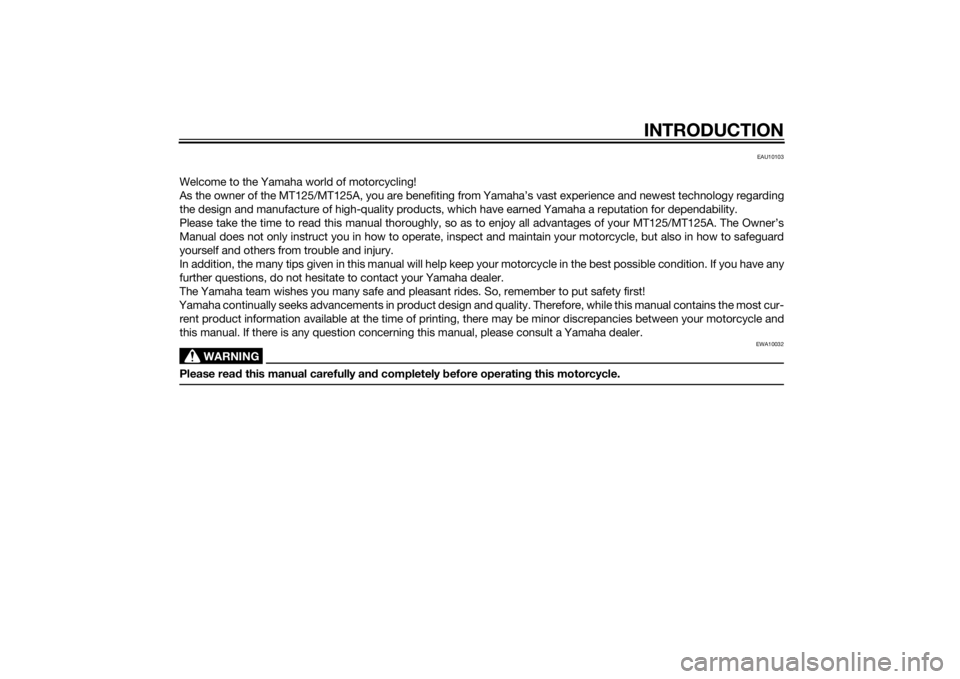
INTRODUCTION
EAU10103
Welcome to the Yamaha world of motorcycling!
As the owner of the MT125/MT125A, you are benefiting from Yamaha’s vast experience and newest technology regarding
the design and manufacture of high-quality products, which have earned Yamaha a reputation for dependability.
Please take the time to read this manual thoroughly, so as to enjoy all advantages of your MT125/MT125A. The Owner’s
Manual does not only instruct you in how to operate, inspect and maintain your motorcycle, but also in how to safeguard
yourself and others from trouble and injury.
In addition, the many tips given in this manual will help keep your motorcycle in the best possible condition. If you have any
further questions, do not hesitate to contact your Yamaha dealer.
The Yamaha team wishes you many safe and pleasant rides. So, remember to put safety first!
Yamaha continually seeks advancements in product design and quality. Therefore, while this manual contains the most cur-
rent product information available at the time of printing, there may be minor discrepancies between your motorcycle and
this manual. If there is any question concerning this manual, please consult a Yamaha dealer.
WARNING
EWA10032
Please read this manual carefully and completely before operating this motorcycle.
U5D7E4E0.book Page 1 Thursday, July 10, 2014 3:01 PM
Page 4 of 96

IMPORTANT MANUAL INFORMATION
EAU10134
Particularly important information is distinguished in this manual by the following notations:
*Product and specifications are subject to change without notice.This is the safety alert symbol. It is used to alert you to potential personal injury
hazards. Obey all safety messages that follow this symbol to avoid possible injury
or death.
A WARNING indicates a hazardous situation which, if not avoided, could result in
death or serious injury.
A NOTICE indicates special precautions that must be taken to avoid damage to the
vehicle or other property.
A TIP provides key information to make procedures easier or clearer.
WARNING
NOTICETIP
U5D7E4E0.book Page 1 Thursday, July 10, 2014 3:01 PM
Page 6 of 96

TABLE OF CONTENTSSAFETY INFORMATION.................. 1-1
DESCRIPTION.................................. 2-1
Left view ......................................... 2-1
Right view ....................................... 2-2
Controls and instruments ............... 2-3
INSTRUMENT AND CONTROL
FUNCTIONS...................................... 3-1
Main switch/steering lock............... 3-1
Indicator lights and warning
lights............................................ 3-2
Multi-function meter unit ................ 3-4
Handlebar switches ...................... 3-11
Clutch lever .................................. 3-13
Shift pedal .................................... 3-13
Brake lever.................................... 3-13
Brake pedal .................................. 3-14
ABS (for ABS models) .................. 3-14
Fuel tank cap ................................ 3-15
Fuel ............................................... 3-16
Catalytic converter ....................... 3-17
Rider seat ..................................... 3-18
Sidestand ..................................... 3-18
Ignition circuit cut-off system ....... 3-19FOR YOUR SAFETY –
PRE-OPERATION CHECKS............. 4-1
OPERATION AND IMPORTANT
RIDING POINTS................................ 5-1
Starting the engine .......................... 5-1
Shifting ............................................ 5-2
Tips for reducing fuel
consumption ................................ 5-3
Engine break-in ............................... 5-3
Parking ............................................ 5-4
PERIODIC MAINTENANCE AND
ADJUSTMENT................................... 6-1
Owner’s tool kit ............................... 6-2
Periodic maintenance chart for the
emission control system .............. 6-3
General maintenance and
lubrication chart ........................... 6-4
Removing and installing cowlings... 6-8
Checking the spark plug ................. 6-9
Engine oil and oil filter element ..... 6-10
Coolant.......................................... 6-13
Replacing the air filter element
and cleaning the check hose..... 6-14
Checking the engine idling
speed ......................................... 6-15
Adjusting the throttle grip free
play ............................................ 6-15
Valve clearance ............................. 6-16
Tires .............................................. 6-16Cast wheels .................................. 6-19
Adjusting the clutch lever free
play ............................................ 6-19
Checking the front brake lever
free play..................................... 6-20
Adjusting the brake pedal free
play ............................................ 6-20
Brake light switches ..................... 6-21
Checking the front and rear brake
pads .......................................... 6-21
Checking the brake fluid level ...... 6-22
Changing the brake fluid .............. 6-23
Drive chain slack........................... 6-24
Cleaning and lubricating the drive
chain.......................................... 6-25
Checking and lubricating the
cables ........................................ 6-26
Checking and lubricating the
throttle grip and cable ............... 6-26
Checking and lubricating the
brake and clutch levers ............. 6-26
Checking and lubricating the
brake pedal ............................... 6-27
Checking and lubricating the
sidestand................................... 6-27
Lubricating the swingarm
pivots......................................... 6-28
Checking the front fork ................. 6-28
Checking the steering................... 6-29
Checking the wheel bearings ....... 6-29
Battery .......................................... 6-30U5D7E4E0.book Page 1 Thursday, July 10, 2014 3:01 PM
Page 8 of 96

1-1
1
SAFETY INFORMATION
EAU1028B
Be a Responsible Owner
As the vehicle’s owner, you are re-
sponsible for the safe and proper oper-
ation of your motorcycle.
Motorcycles are single-track vehicles.
Their safe use and operation are de-
pendent upon the use of proper riding
techniques as well as the expertise of
the operator. Every operator should
know the following requirements be-
fore riding this motorcycle.
He or she should:
Obtain thorough instructions from
a competent source on all aspects
of motorcycle operation.
Observe the warnings and mainte-
nance requirements in this Own-
er’s Manual.
Obtain qualified training in safe
and proper riding techniques.
Obtain professional technical ser-
vice as indicated in this Owner’s
Manual and/or when made neces-
sary by mechanical conditions.Never operate a motorcycle with-
out proper training or instruction.
Take a training course. Beginners
should receive training from a cer-
tified instructor. Contact an autho-
rized motorcycle dealer to find out
about the training courses nearest
you.
Safe Riding
Perform the pre-operation checks
each time you use the vehicle to make
sure it is in safe operating condition.
Failure to inspect or maintain the vehi-
cle properly increases the possibility of
an accident or equipment damage.
See page 4-1 for a list of pre-operation
checks.
This motorcycle is designed to
carry the operator and a passen-
ger.
The failure of motorists to detect
and recognize motorcycles in traf-
fic is the predominating cause of
automobile/motorcycle accidents.
Many accidents have been
caused by an automobile driver
who did not see the motorcycle.
Making yourself conspicuous ap-pears to be very effective in reduc-
ing the chance of this type of
accident.
Therefore:
• Wear a brightly colored jacket.
• Use extra caution when you are
approaching and passing
through intersections, since in-
tersections are the most likely
places for motorcycle accidents
to occur.
• Ride where other motorists can
see you. Avoid riding in another
motorist’s blind spot.
• Never maintain a motorcycle
without proper knowledge.
Contact an authorized motorcy-
cle dealer to inform you on ba-
sic motorcycle maintenance.
Certain maintenance can only
be carried out by certified staff.U5D7E4E0.book Page 1 Thursday, July 10, 2014 3:01 PM
Page 16 of 96
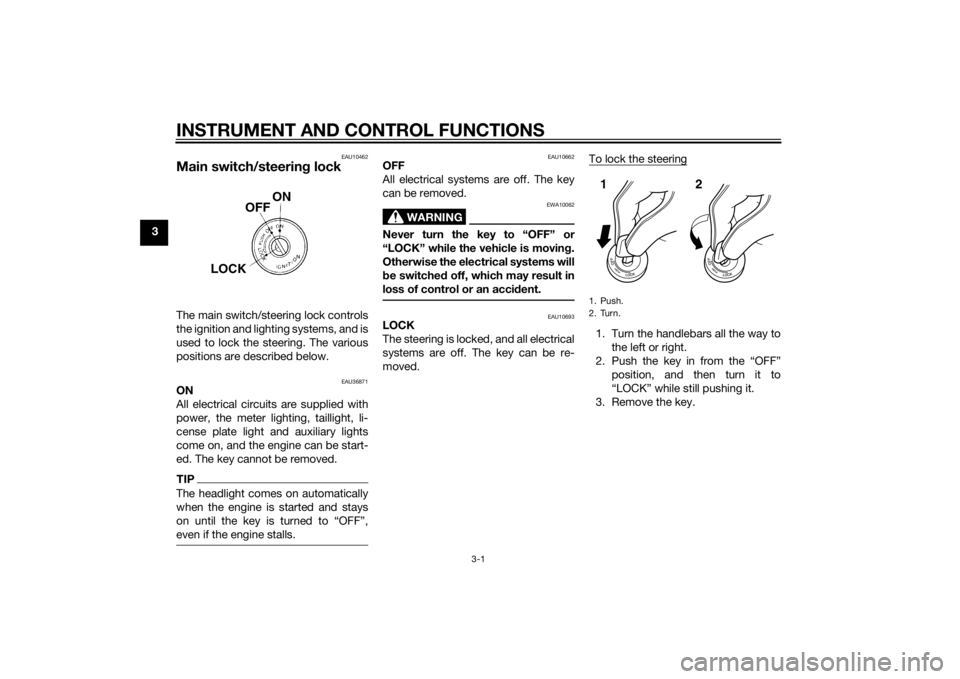
INSTRUMENT AND CONTROL FUNCTIONS
3-1
3
EAU10462
Main switch/steering lockThe main switch/steering lock controls
the ignition and lighting systems, and is
used to lock the steering. The various
positions are described below.
EAU36871
ON
All electrical circuits are supplied with
power, the meter lighting, taillight, li-
cense plate light and auxiliary lights
come on, and the engine can be start-
ed. The key cannot be removed.TIPThe headlight comes on automatically
when the engine is started and stays
on until the key is turned to “OFF”,
even if the engine stalls.
EAU10662
OFF
All electrical systems are off. The key
can be removed.
WARNING
EWA10062
Never turn the key to “OFF” or
“LOCK” while the vehicle is moving.
Otherwise the electrical systems will
be switched off, which may result in
loss of control or an accident.
EAU10693
LOCK
The steering is locked, and all electrical
systems are off. The key can be re-
moved.To lock the steering
1. Turn the handlebars all the way to
the left or right.
2. Push the key in from the “OFF”
position, and then turn it to
“LOCK” while still pushing it.
3. Remove the key.1. Push.
2. Turn.12
U5D7E4E0.book Page 1 Thursday, July 10, 2014 3:01 PM
Page 17 of 96
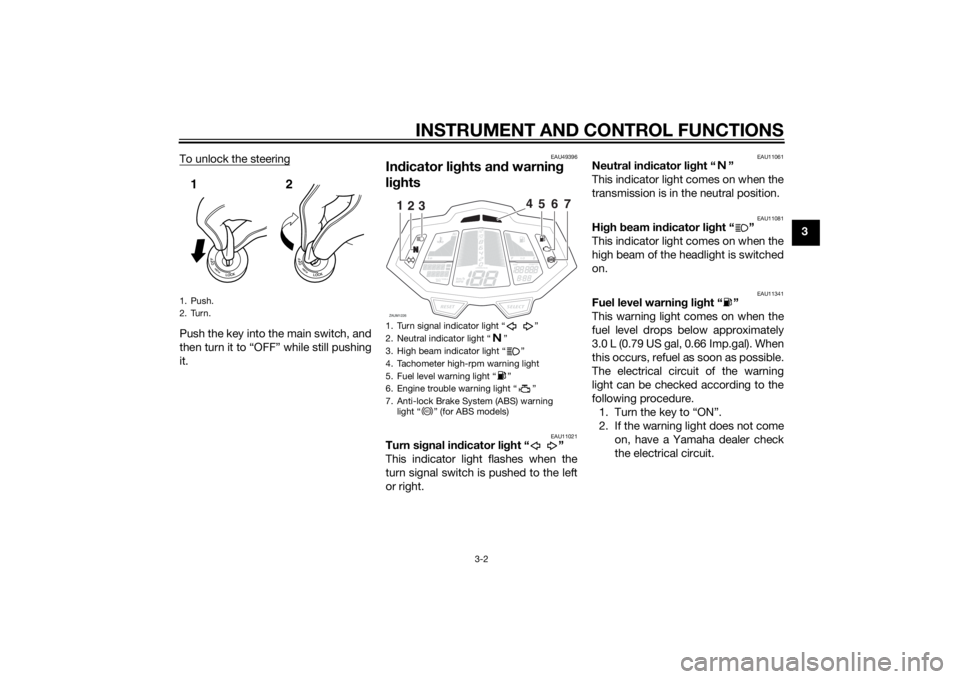
INSTRUMENT AND CONTROL FUNCTIONS
3-2
3 To unlock the steering
Push the key into the main switch, and
then turn it to “OFF” while still pushing
it.
EAU49396
Indicator lights and warning
lights
EAU11021
Turn signal indicator light “ ”
This indicator light flashes when the
turn signal switch is pushed to the left
or right.
EAU11061
Neutral indicator light “ ”
This indicator light comes on when the
transmission is in the neutral position.
EAU11081
High beam indicator light “ ”
This indicator light comes on when the
high beam of the headlight is switched
on.
EAU11341
Fuel level warning light “ ”
This warning light comes on when the
fuel level drops below approximately
3.0 L (0.79 US gal, 0.66 Imp.gal). When
this occurs, refuel as soon as possible.
The electrical circuit of the warning
light can be checked according to the
following procedure.
1. Turn the key to “ON”.
2. If the warning light does not come
on, have a Yamaha dealer check
the electrical circuit.
1. Push.
2. Turn.12
1. Turn signal indicator light Ž
2. Neutral indicator light Ž
3. High beam indicator light Ž
4. Tachometer high-rpm warning light
5. Fuel level warning light Ž
6. Engine trouble warning light Ž
7. Anti-lock Brake System (ABS) warning
light Ž (for ABS models)ZAUM1226
SELECT
RESETkm/L/100kmMPG
km/h
MPH
Lo
Hi
1/2ODO
FTRIP12
x1000r/min
OILOIL
123
5
4
6
7
ABS
U5D7E4E0.book Page 2 Thursday, July 10, 2014 3:01 PM
Page 18 of 96
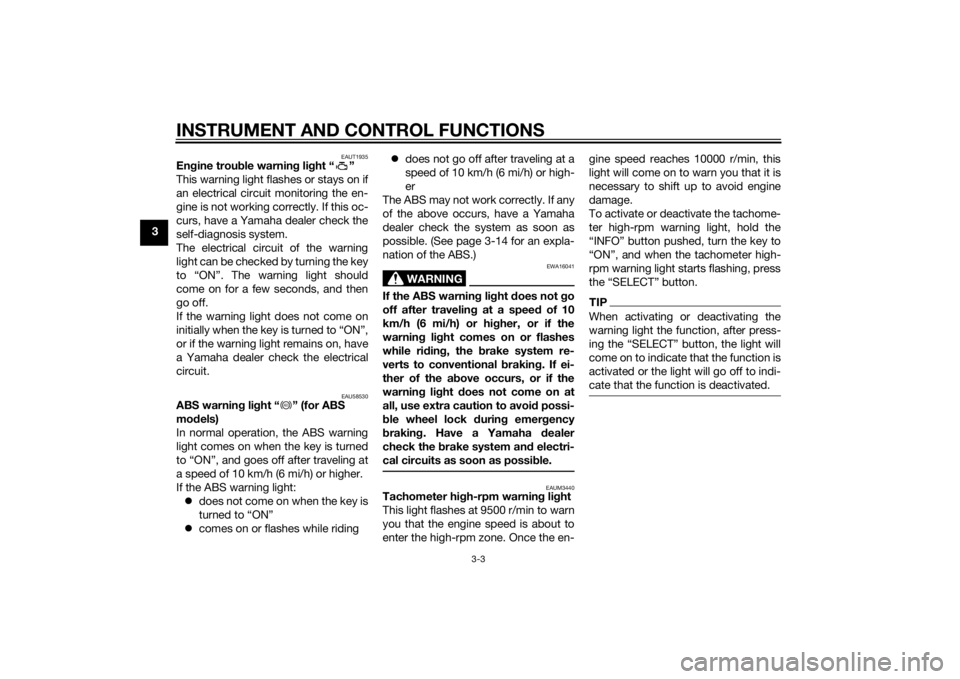
INSTRUMENT AND CONTROL FUNCTIONS
3-3
3
EAUT1935
Engine trouble warning light “ ”
This warning light flashes or stays on if
an electrical circuit monitoring the en-
gine is not working correctly. If this oc-
curs, have a Yamaha dealer check the
self-diagnosis system.
The electrical circuit of the warning
light can be checked by turning the key
to “ON”. The warning light should
come on for a few seconds, and then
go off.
If the warning light does not come on
initially when the key is turned to “ON”,
or if the warning light remains on, have
a Yamaha dealer check the electrical
circuit.
EAU58530
ABS warning light “ ” (for ABS
models)
In normal operation, the ABS warning
light comes on when the key is turned
to “ON”, and goes off after traveling at
a speed of 10 km/h (6 mi/h) or higher.
If the ABS warning light:
does not come on when the key is
turned to “ON”
comes on or flashes while ridingdoes not go off after traveling at a
speed of 10 km/h (6 mi/h) or high-
er
The ABS may not work correctly. If any
of the above occurs, have a Yamaha
dealer check the system as soon as
possible. (See page 3-14 for an expla-
nation of the ABS.)
WARNING
EWA16041
If the ABS warning light does not go
off after traveling at a speed of 10
km/h (6 mi/h) or higher, or if the
warning light comes on or flashes
while riding, the brake system re-
verts to conventional braking. If ei-
ther of the above occurs, or if the
warning light does not come on at
all, use extra caution to avoid possi-
ble wheel lock during emergency
braking. Have a Yamaha dealer
check the brake system and electri-
cal circuits as soon as possible.
EAUM3440
Tachometer high-rpm warning light
This light flashes at 9500 r/min to warn
you that the engine speed is about to
enter the high-rpm zone. Once the en-gine speed reaches 10000 r/min, this
light will come on to warn you that it is
necessary to shift up to avoid engine
damage.
To activate or deactivate the tachome-
ter high-rpm warning light, hold the
“INFO” button pushed, turn the key to
“ON”, and when the tachometer high-
rpm warning light starts flashing, press
the “SELECT” button.
TIPWhen activating or deactivating the
warning light the function, after press-
ing the “SELECT” button, the light will
come on to indicate that the function is
activated or the light will go off to indi-
cate that the function is deactivated.
ABS
U5D7E4E0.book Page 3 Thursday, July 10, 2014 3:01 PM
Page 19 of 96
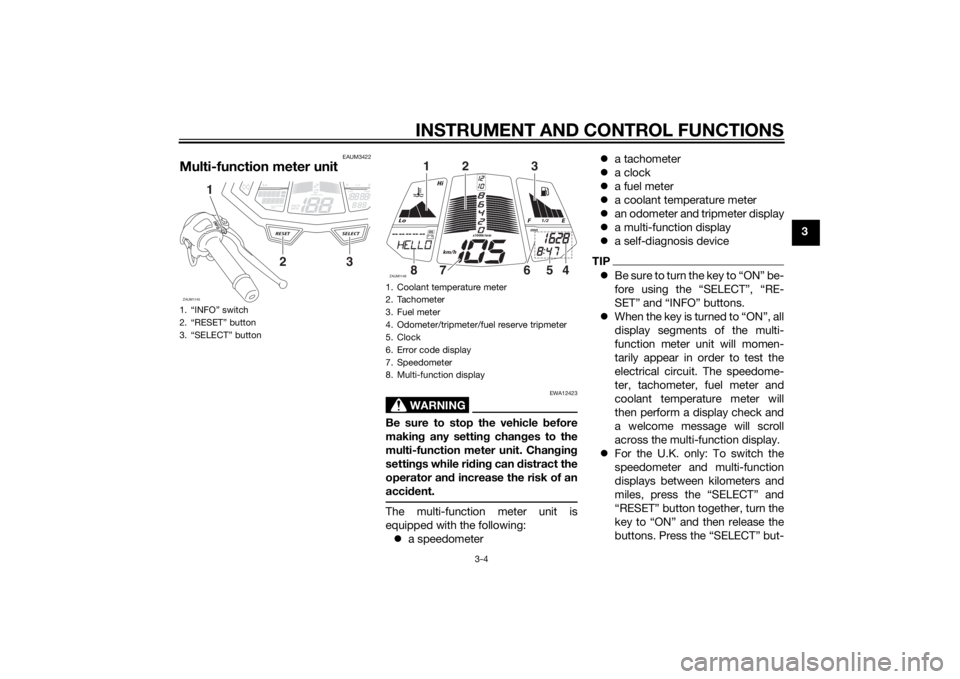
INSTRUMENT AND CONTROL FUNCTIONS
3-4
3
EAUM3422
Multi-function meter unit
WARNING
EWA12423
Be sure to stop the vehicle before
making any setting changes to the
multi-function meter unit. Changing
settings while riding can distract the
operator and increase the risk of an
accident.The multi-function meter unit is
equipped with the following:
a speedometera tachometer
a clock
a fuel meter
a coolant temperature meter
an odometer and tripmeter display
a multi-function display
a self-diagnosis device
TIPBe sure to turn the key to “ON” be-
fore using the “SELECT”, “RE-
SET” and “INFO” buttons.
When the key is turned to “ON”, all
display segments of the multi-
function meter unit will momen-
tarily appear in order to test the
electrical circuit. The speedome-
ter, tachometer, fuel meter and
coolant temperature meter will
then perform a display check and
a welcome message will scroll
across the multi-function display.
For the U.K. only: To switch the
speedometer and multi-function
displays between kilometers and
miles, press the “SELECT” and
“RESET” button together, turn the
key to “ON” and then release the
buttons. Press the “SELECT” but-
1. “INFO” switch
2. “RESET” button
3. “SELECT” buttonZAUM1145
SELECT
RESET
INFO
km/L/100kmMPG
km/h
MPH
Lo
1/2ODO
FTRIP
x1000r/min
OILOIL2
3
1
1. Coolant temperature meter
2. Tachometer
3. Fuel meter
4. Odometer/tripmeter/fuel reserve tripmeter
5. Clock
6. Error code display
7. Speedometer
8. Multi-function displayZAUM1146
km/h
Lo
Hi
1/2ODO
x1000r/min
OIL1
2
3
4
5
6
7
8
U5D7E4E0.book Page 4 Thursday, July 10, 2014 3:01 PM
Page 20 of 96
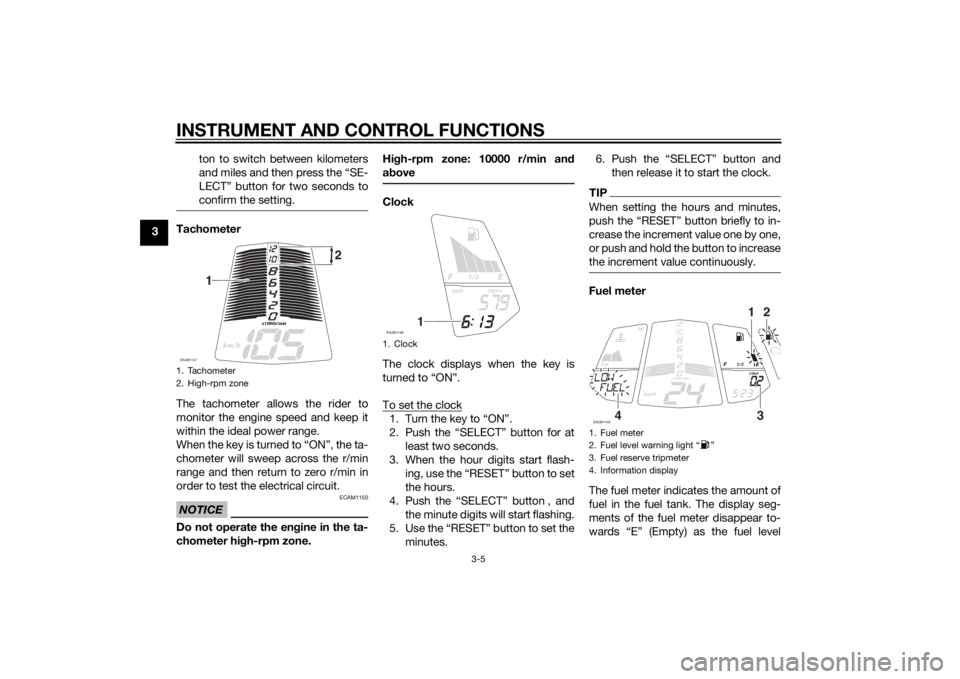
INSTRUMENT AND CONTROL FUNCTIONS
3-5
3ton to switch between kilometers
and miles and then press the “SE-
LECT” button for two seconds to
confirm the setting.
Tachometer
The tachometer allows the rider to
monitor the engine speed and keep it
within the ideal power range.
When the key is turned to “ON”, the ta-
chometer will sweep across the r/min
range and then return to zero r/min in
order to test the electrical circuit.NOTICE
ECAM1150
Do not operate the engine in the ta-
chometer high-rpm zone.High-rpm zone: 10000 r/min and
above
Clock
The clock displays when the key is
turned to “ON”.
To set the clock1. Turn the key to “ON”.
2. Push the “SELECT” button for at
least two seconds.
3. When the hour digits start flash-
ing, use the “RESET” button to set
the hours.
4. Push the “SELECT” button , and
the minute digits will start flashing.
5. Use the “RESET” button to set the
minutes.6. Push the “SELECT” button and
then release it to start the clock.
TIPWhen setting the hours and minutes,
push the “RESET” button briefly to in-
crease the increment value one by one,
or push and hold the button to increase
the increment value continuously.Fuel meter
The fuel meter indicates the amount of
fuel in the fuel tank. The display seg-
ments of the fuel meter disappear to-
wards “E” (Empty) as the fuel level
1. Tachometer
2. High-rpm zoneZAUM1147
km/h
x1000r/min
1
2
1. ClockZAUM1148
1/2
ODO
TRIP1
1
1. Fuel meter
2. Fuel level warning light Ž
3. Fuel reserve tripmeter
4. Information displayZAUM1149
km/h
Lo
Hi
1/2
FTRIP
x1000r/min
2
13
4
U5D7E4E0.book Page 5 Thursday, July 10, 2014 3:01 PM
Page 21 of 96
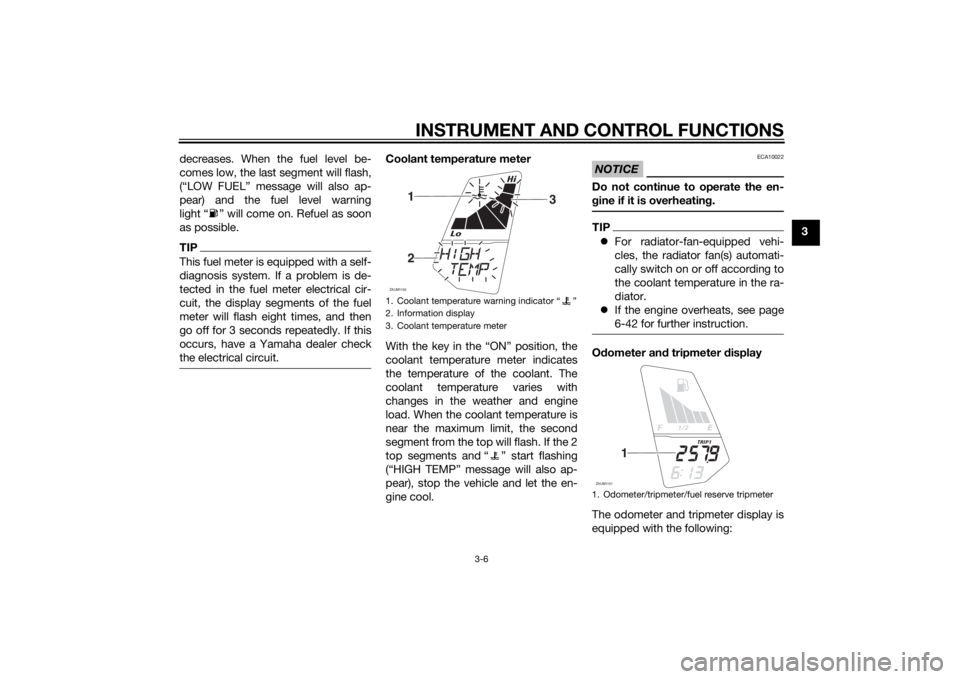
INSTRUMENT AND CONTROL FUNCTIONS
3-6
3 decreases. When the fuel level be-
comes low, the last segment will flash,
(“LOW FUEL” message will also ap-
pear) and the fuel level warning
light “ ” will come on. Refuel as soon
as possible.
TIPThis fuel meter is equipped with a self-
diagnosis system. If a problem is de-
tected in the fuel meter electrical cir-
cuit, the display segments of the fuel
meter will flash eight times, and then
go off for 3 seconds repeatedly. If this
occurs, have a Yamaha dealer check
the electrical circuit.
Coolant temperature meter
With the key in the “ON” position, the
coolant temperature meter indicates
the temperature of the coolant. The
coolant temperature varies with
changes in the weather and engine
load. When the coolant temperature is
near the maximum limit, the second
segment from the top will flash. If the 2
top segments and “ ” start flashing
(“HIGH TEMP” message will also ap-
pear), stop the vehicle and let the en-
gine cool.
NOTICE
ECA10022
Do not continue to operate the en-
gine if it is overheating.TIPFor radiator-fan-equipped vehi-
cles, the radiator fan(s) automati-
cally switch on or off according to
the coolant temperature in the ra-
diator.
If the engine overheats, see page
6-42 for further instruction.Odometer and tripmeter display
The odometer and tripmeter display is
equipped with the following:
1. Coolant temperature warning indicator “ ”
2. Information display
3. Coolant temperature meterZAUM1150
Lo
Hi
1
3
2
1. Odometer/tripmeter/fuel reserve tripmeterZAUM1151
1/2
TRIP1
1
U5D7E4E0.book Page 6 Thursday, July 10, 2014 3:01 PM